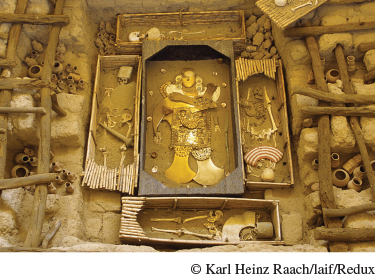ZOOMING IN: The Lord of Sipan and the Lady of Cao

I n the mid-
Much more obvious is his high social status, for which he has been dubbed the Lord of Sipan, named for the town in Peru where the archeological site is located. Laid to rest in the official and ceremonial finery he likely donned in life, the Lord of Sipan was bedecked in gold. He wore a huge gold crescent headdress, a gold face mask, two necklaces with gold and silver beads in the shape of oversized peanuts, and gold earspools exquisitely inlaid with turquoise; he had a gold warrior’s shield on his back and a golden scepter in his hand. Hundreds of pots contained food and drink, while 451 ceremonial objects also accompanied the burial. Guarding the entrance to his tomb was the skeleton of a man with his feet cut off, presumably to prevent him from leaving his post. Buried with the Lord of Sipan were six other individuals: a young child (perhaps his own?); two robust men (perhaps ritually sacrificed warriors?); and three young women (perhaps his wives?). A dog, claimed by local traditions to guide the dead into the afterworld, and two llamas also attended the lord in death. In its archeological significance and its material splendor, this burial site has been compared to that of Tutankhamen, the young pharaoh of Egypt. (See the photo of his burial site above.)
Clearly, the Lord of Sipan was a very high-
At the time the Lord of Sipan came to light, it was widely assumed that the ruling elite of Moche society was all male. Then in 2005, another remarkable burial site was uncovered, containing the intact body of a young woman who had died in childbirth around 450 C.E. while still in her twenties. Now known as the Lady of Cao, she had been carefully wrapped in hundreds of yards of cotton strips, wore long braided hair, and bore numerous tattoos of snakes, crabs, and spiders on her arms and legs. Accompanying her was a huge collection of elaborate grave goods indicating great wealth: fifteen elaborate necklaces, gold sewing needles, weaving tools, beautiful jewelry, and a vessel depicting a nursing mother. But beyond these feminine objects were more surprising signs of real power. Her nose rings featured designs of men wielding war clubs and heads being pecked by condors. Two copper and wood staffs, symbols of authority, were entombed with her, as well as many weapons, including two massive war clubs and twenty-

So was the Lady of Cao a local ruler in her own right or simply a woman from an elite family? The case for her political and religious role has been strengthened by the subsequent discovery of eight more burials of prominent Moche women. One of them contained a tall silver goblet, very similar to those depicted in Moche artistic scenes of ritual sacrifice and the consumption of blood. Some scholars suggest that Moche society was highly decentralized, with men in positions of authority in some communities and women in others. Thus the Lord of Sipan and the Lady of Cao, though living several hundred years apart, may have played equivalent roles in Moche society.
Questions: What do we learn about Moche society from these two figures? If you could interview these individuals, what would you want to ask them? What might be inferred from these burials about Moche understandings of the afterlife?